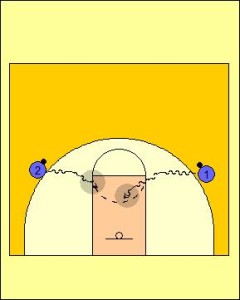Stride Stop Shooting Drill
The Stride Stop Shooting Drill is a fantastic activity for developing a player’s ability to use the stride stop technique within their shooting action. The stride stop is a very important technique for players to be able to utilise to increase the speed of their shot release. Especially in the senior levels of basketball competition, developing a quick release shot is a “must”.
A stride stop helps players move more seamlessly from a dribbling action into their jump shot. The stride stop action also helps channel some of the player’s momentum that will assist with the generation of force and elevation within the shooting action. Players of course can still utilise a jump stop, but when creating a shot off the dribble and under pressure from a defender the stride stop is the technique of choice.

The Stride Stop Shooting Drill helps players not only refine their technique, but also help with areas on the floor they should be attacking to create defensive rotations that will also provide offensive passing options.
When the players are dribbling to the middle of the floor they will use one and two dribble movements. In both situations, we want the players to be curling as they dribble bringing them closer to the basket with each dribble. They should be aiming to enter into the keyway below the elbow. What this action achieves is that once the defender is on the hip of the offensive player they will never be able to recover and if they do try to contest the jump shot they will have to reach across the body of the shooter. This increases significantly the chances of a defensive foul happening.
When performing the one dribble stride stop jump shot the player (Two) should be aiming to reach the elbow.
For a player (One) performing a two-dribble movement they should be looking to reach the split line around the broken circle area. Modern courts will not have the broken circle marking but this is just two to three feet below where the foul line is.
The diagrammed position is very important as these spots will trigger the rotation by the help defence (if it is going to happen at all). Rotations by defenders around the basket will always result in open offensive targets.
If the help defence does not come then these desired shooting positions will be high percentage shots, especially as a result of the two-dribble movement.
The Stride Stop Shooting Drill starts with two lines of players foul line extended on either side of the floor. Both lines alternate taking turns dribbling and utilising the stride stop in their one and two dribble shooting action.
The foot closest to halfway (high side) will be the leg which initiates the first step. For players using one dribble there will be two steps involved in the movement. The first step will be the high side foot and the second will be the pivot foot.
For players using two dribble there will be four steps involved in the movement. These will be:
- High side foot makes the first step
- Low side foot is the second step
- High side foot for the second time is the third step
- Low side foot for the second time becomes the pivot foot and the forth, and final step in the series
Points of Emphasis
- Players need to attack the basket at game pace
- Players need to be explosive in their first step so they can generate a good distance from each step they take and reach the desire positions on the floor
- The dribble should be outside the line of the high side foot so the ball is protected by the leg of the offensive player from the defender. This position also reduces the risk of the offensive player dribbling the ball on their foot or accidently kicking and basketball
- Players will need to stay low in their dribble so they can dribble at full speed and then perform a balanced shot at the end of the movement
- Players need to explode off the floor to help generate elevation that will assist in creating space and separation between the offensive player and defensive match-up when closely guarded.

The second movement in the series is for the players to now dribble to the baseline.
The lead foot remains to the high side of the player. One way of teaching this footwork to players is to have them jab step as though they are going to be heading towards the middle of the floor. Then following the jab step the same footsteps across the player body towards the baseline.
In the one dribble movement, the first step will become the pivot foot as well. This type of skill would be performed where the defender falls for the shot fake and the offensive player quickly moves away from the direction of the jab step and “stops and pops” quickly shooting the ball.
Within the two dribble variation the initial movement discussed above is performed but instead of pivoting in the first instance on the high side foot, it will be the second time the lead floor hits the ground that the pivot is performed.
Variation
A coach can be placed at each desired shooting position so the offensive players have to shoot over a defender.
The next variation will be to add a defender so the players have to utilise the techniques highlighted in the Stride Stop Shooting Drill under pressure.
The Stride Stop Shooting Drill is a fantastic option for having players gain a large amount of repetitions using the stride stop within their shooting technique while also helping with the establishment of tactical principles such as the desired shooting spots. To help the development of their players coaches need to integrate the additional variations discussed above to keep the Stride Stop Shooting Drill challenging for players.








Leave a Reply